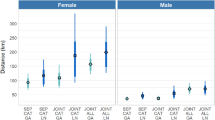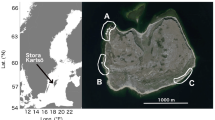Abstract
In using a population projection model to help manage the conservation of along-lived species, we usually need a reliable estimate of adult survival. Mark-recapture studies are often used to estimate survival, and typically require the assumption that there is no permanent emigration from the study area. We consider how such a study might be extended to allow for local emigration, that is, movement of individuals into an area peripheral to the study area. In particular, we focus on the question as to how much field effort is required in this peripheral area in order to obtain sufficiently precise estimates of both the survival probability and the probability of local emigration. We consider the use of multi-state, mark-recapture models as a means of providing these estimates and show how to assess the precision of a potential study design by calculating the expected confidence limits associated with the resulting estimates. We considera range of design scenarios for the situation that motivated this work, involving a population of Hector’s dolphins in New Zealand. For this case, it appears that there is little gain in precision once a capture probability of 0.4 is reached in the peripheral area.
Similar content being viewed by others
References
Arnason, A. N. (1972), “Parameter Estimates from Mark-Recapture Experiments on Two Populations Subject to Migration and Death,” Researches on Population Ecology, 13, 97–113.
— (1973), “The Estimation of Population Size, Migration Rates, and Survival in a Stratified Population,” Researches on Population Ecology, 15, 1–8.
Brownie, C., Hines, J. E., Nichols, J. D., Pollock, K. H., and Hestbeck, J. B. (1993), “Capture-Recapture Studies for Multiple State Including Non-Markovian Transitions,” Biometrics, 49, 1173–1187.
Burnham, K. P., Anderson, D. R., White, G. C., Brownie, C., and Pollock, K. H. (1987), “Design and Analysis Methods for Fish Survival Experiments Based on Release-Recapture,” American Fisheries Society Monograph 5.
Cam, E., Hines, J. E., Monnat, J.-Y., Nichols, J. D., and Danchin, E. (1998), “Are Adult Non-breeders Prudent Parents? The Kittiwake Model,” Ecology, 79, 2917–2930.
Cameron, C., Barker, R., Fletcher, D., Slooten, E., and Dawson, S. (1999), “Modelling Survival of Hector’s Dolphins Around Banks Peninsula, New Zealand,” Journal of Agricultural, Biological, and Environmental Statistics, 4, 1–10.
Carothers, A. D. (1973), “The Effects of Unequal Catchability on Jolly-Seber Estimates,” Biometrics, 29, 79–100.
Dawson, S. M., and Slooten, E. (1993), “Conservation of Hector’s Dolphins, The Case and Process Which led to the Establishment of the Banks Peninsula Marine Mammal Sanctuary,” Aquatic Conservation, 3, 207–221.
Heppell, S. S., Caswell, H., and Crowder, L. B. (2000), “Life Histories and Elasticity Patterns, Perturbation Analysis for Species with Minimal Demographic Data,” Ecology, 81, 654–665.
Kendall, W. L., Nichols, J. D., and Hines, J. E. (1997), “Estimating Temporary Emigration Using Capture-Recapture Data with Pollock’s Robust Design,” Ecology, 78, 563–578.
Lebreton, J-D., Burnham, K. P., Clobert, J., and Anderson, D.R. (1992), “Modelling Survival and Testing Biological Hypotheses Sing Marked Animals, A Unified Approach with Case Studies,” Ecological Monographs 62, 67–118.
McCullagh, P., and Nelder, J. A. (1989), Generalized Linear Models (2nd ed.), London: Chapman and Hall
Nichols, J. D., and Kendall, W. L. (1995), “The Use of Multi-state Capture-Recapture Models to Address Questions in Evolutionary Ecology,” Journal of Applied Statistics, 22, 835–846.
Pollock, K. H., Nichols, J. D., Brownie, C., and Hines, J. E. (1990), “Statistical Inference for Capture-Recapture Experiments,” Wildlife Monographs, 107, 1–97.
Schwarz, C. J., Schweigert, J. F., and Arnason, A. N. (1993), “Estimating Migration Rates Using Tag-Recovery Data,” Biometrics, 49, 177–193.
Scofield, P., Fletcher, D. J., and Robertson, C. (2001), “Titi (Sooty Shearwaters) on Whero Island, An Analysis of Historic Banding Data Using Modern Capture-Recapture Techniques,” Journal of Agricultural, Biological, and Environmental Statistics, 6, 268–280.
Slooten, E., Dawson, S. M., and Lad, F. (1992), “Survival Rates of Photographically Identified Hector’s Dolphins from 1984 to 1988,” Marine Mammal Science, 8, 327–343.
White, G. C., and Burnham, K. P. (1999), “Program MARK, Survival Estimation from Populations of Marked Animals,” Bird Study, 46 Supplement, 120–138.
Author information
Authors and Affiliations
Corresponding author
Rights and permissions
About this article
Cite this article
Fletcher, D., Dawson, S. & Slooten, E. Designing a mark-recapture study to allow for local emigration. JABES 7, 586–593 (2002). https://doi.org/10.1198/108571102799
Received:
Revised:
Issue Date:
DOI: https://doi.org/10.1198/108571102799




